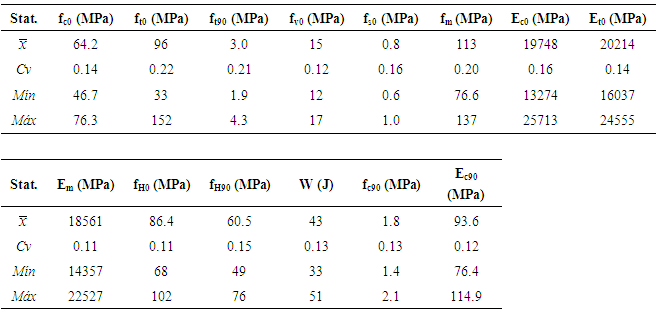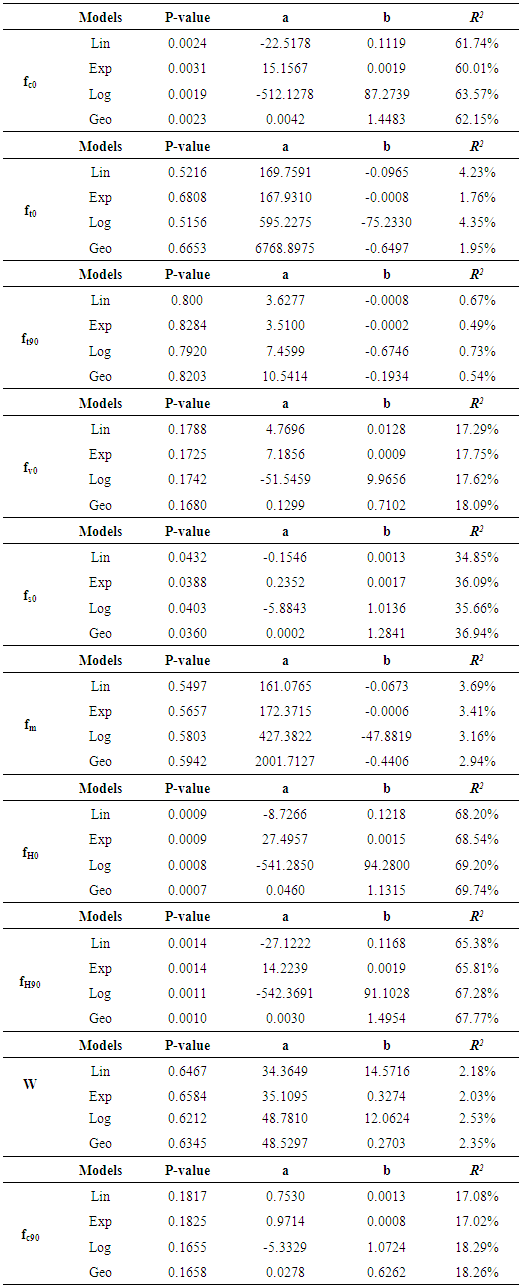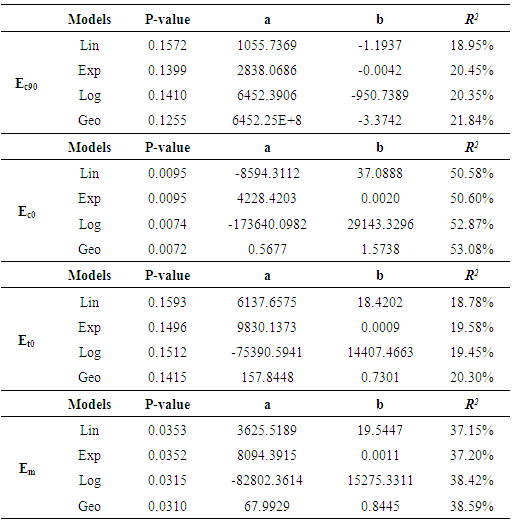-
Paper Information
- Next Paper
- Paper Submission
-
Journal Information
- About This Journal
- Editorial Board
- Current Issue
- Archive
- Author Guidelines
- Contact Us
International Journal of Materials Engineering
p-ISSN: 2166-5389 e-ISSN: 2166-5400
2016; 6(3): 92-96
doi:10.5923/j.ijme.20160603.05

Full Characterization of Vatairea sp Wood Specie
Francisco A. Rocco Lahr1, Bruno H. C. Aftimus2, Felipe N. Arroyo3, Diego H. De Almeida4, André L. Christoforo3, Eduardo Chahud5, Luiz A. M. Nunes Branco6
1Department of Structural Engineering (SET), São Paulo University (EESC/USP), São Carlos, Brazil
2Department of Civil Engineering, University Center of Educational Foundation of Barretos (UNIFEB), Barretos, Brazil
3Centre for Innovation and Technology in Composites - CITeC, Department of Civil Engineering (DECiv), Federal University of São Carlos, São Carlos, Brazil
4Department of Engineering, Pitágoras College, Poços de Caldas, Brazil
5Department of Civil Engineering, Federal University of Minas Gerais (UFMG), Belo Horizonte, Brazil
6Faculty of Engineering and Architecture, FUMEC University, Belo Horizonte, Brazil
Correspondence to: André L. Christoforo, Centre for Innovation and Technology in Composites - CITeC, Department of Civil Engineering (DECiv), Federal University of São Carlos, São Carlos, Brazil.
| Email: |  |
Copyright © 2016 Scientific & Academic Publishing. All Rights Reserved.
This work is licensed under the Creative Commons Attribution International License (CC BY).
http://creativecommons.org/licenses/by/4.0/

In Brazil, wood is a material which has been used for years in different purposes. The variety of Brazilian tropical wood species is expressive, nonetheless only a few of them are considered in structural design. Taking in account possibility of eventual shortages of these well-known wood species, characterization of alternative essences is presented as fundamental for maintenance of wood supply for civil construction. In Brazil, the structural dimensioning and timber characterization are specified by ABNT NBR 7190:1997 (Timber structures design), in its Annex B. This work aimed, with the aid of Brazilian Code, determining physical (4) and mechanical (13) properties of Angelim Saia (Vatairea sp.). Besides, with regression model (linear, exponential, geometric and logarithmic) based in analysis of variance (ANOVA), it was aimed to estimate resistance values and stiffness in function of the density, once this is an easy-obtainable property for wood. From a set of twelve aleatory pieces, twelve specimens were produced for each test type, totalizing 204 experimental measurements. Results of mechanical properties showed compatible performance with other species already established for use in structure, which shows the potential of Angelim Saia for structural purposes. From regression models for estimate strength and stiffness values, it was possible conclude that not all properties can be estimate by density. Better results were showed by the geometric model in estimation of hardness parallel to grain, who provided determination coefficient (R²) close to 70%.
Keywords: Vatairea sp., Characterization, Density, Regression model
Cite this paper: Francisco A. Rocco Lahr, Bruno H. C. Aftimus, Felipe N. Arroyo, Diego H. De Almeida, André L. Christoforo, Eduardo Chahud, Luiz A. M. Nunes Branco, Full Characterization of Vatairea sp Wood Specie, International Journal of Materials Engineering , Vol. 6 No. 3, 2016, pp. 92-96. doi: 10.5923/j.ijme.20160603.05.
Article Outline
1. Introduction
- Employing wood in construction is a practice carried out for many years by humanity, since the necessity of store food, overcoming obstacles, until the construction of shelters [1].Initially, exploration of Amazon Tropical Forest was selective and predatory, once demand concentrated once only a few well-known wood species were extracted. This undesirable exploitation led those species (already completely characterized) to almost exhaustion, imposing to the market improve receptivity for new species not yet with a wide application [2].Due to this high demand and few options, the prices of used species increase, give a new moment to Brazilian timber sector, being necessary define which new species can substitute the traditional used species in construction [3, 4]. In addition, with the growing awareness of population the use of materials which cause the minimum damage to the environment, timber originates from planted forests becomes also a building material to be widely considerable [5].As such, Vatairea sp. is an interesting possibility, once this species occurs in several Brazilian regions, including Tocantins, Goiás and Bahia until São Paulo states. It is a very tall tree, with middle-heavy wood and potential satisfactory mechanical properties [6, 7].However, before the using of a new species in any situation, be in roofs, bridges, silos or any others, it is necessary to determine its physical and mechanical properties, thus promoting a better condition to use [5].Full characterization of wood species involves determination of their physical and mechanical properties, obeying requirements of normative Codes. In Brazil, is the NBR 7190 [8] who sets parameters for this characterization. However, the inconvenience of several of these tests and necessity of using heavy equipments, increase costs and make fundamental rely this work to research centers [8].By other side, a physical property easily determined in usual experimental procedures is the apparent density (or simply density), set by ratio between mass and volume a 12% of moisture content (as referenced in Annex B, NBR 7190:1997). As density is a basic physical property, their values can, eventually, allow establish an adequate estimate of the mechanical wood properties [9, 10].Therefore, the aim of this work is determinate the physical and mechanical properties of Vatairea sp. according to pre-defined indications of Brazilian Code, as well as research the possibility of estimating of mechanical properties in function of density.
2. Material and Methods
- In order to reach proper conditions to get the specimens, Vatairea sp wood pieces were duly stored, until showing moisture content by 12%, reference adopted by NBR 7190:1997 [8].Mechanical tests were carried out in Wood and Timber Structures Laboratory (LaMEM), Department of Structural Engineering (SET), School of Engineering of São Carlos (EESC), University of São Paulo (USP). Physical tests were conducted in Federal University of Minas Gerais (UFMG) and FUMEC University laboratories. Statistical procedures were processed in Federal University of São Carlos (UFSCar).Physical and mechanical properties were obtained under the requirements of test methods proposed by the Brazilian Code [8], in its Annex B (Determination of timber properties for structural purposes). The number of experimental determinations is introduced in Table 1, for each property, and it should be noted that, in total, 204 determinations were made.
|
 | (1) |
 | (2) |
 | (3) |
 | (4) |
3. Results and Discussion
- Tables 2 and 3 present means
 , variation coefficients (Cv), smallest (Min) and largest (Max) values for physical and mechanical properties, respectively.The obtained mean value for fc0 (64.2 MPa) is very close to that of Protium heptaphyllum (59 MPa) [11]. According to the authors, this permits utilization in all kinds of structures, for their high strength, far larger than obtained to the Paricá (Schizolobium amazonicum) - 24 MPa [9], Toona ciliate (27 MPa) and Eucalyptus benthamii (37 MPa) [13], proper for light structures.
, variation coefficients (Cv), smallest (Min) and largest (Max) values for physical and mechanical properties, respectively.The obtained mean value for fc0 (64.2 MPa) is very close to that of Protium heptaphyllum (59 MPa) [11]. According to the authors, this permits utilization in all kinds of structures, for their high strength, far larger than obtained to the Paricá (Schizolobium amazonicum) - 24 MPa [9], Toona ciliate (27 MPa) and Eucalyptus benthamii (37 MPa) [13], proper for light structures.
|
|
|
|
4. Conclusions
- The results obtained of this research allow concluding that:- Based on the variation coefficient, Vatairea sp. characterization can be considered according to the required by Brazilian standard;- Following the premises of Brazilian Code, Vatairea sp. is categorized as C40 (dicotyledonous), by presenting a characteristic value of strength in compression parallel to the grain (fc0,k) 51 MPa, indicating a potential good performance for light and heavy structures;- The regression models presented significant estimates and good quality in adjusting (R² bigger than 60%) only for three among the fourteen mechanical properties investigated: strength in compression parallel to the grain, hardness parallel to the grain and hardness normal to the grain;- The regression models geometric presented the better settings, followed by logarithmic models.
ACKNOWLEDGMENTS
- By all support provided, the authors are grateful to Higher Education Improvement Coordination (CAPES); National Council for Scientific and Technological Development (CNPq); and to the four Universities involved.
 Abstract
Abstract Reference
Reference Full-Text PDF
Full-Text PDF Full-text HTML
Full-text HTML




